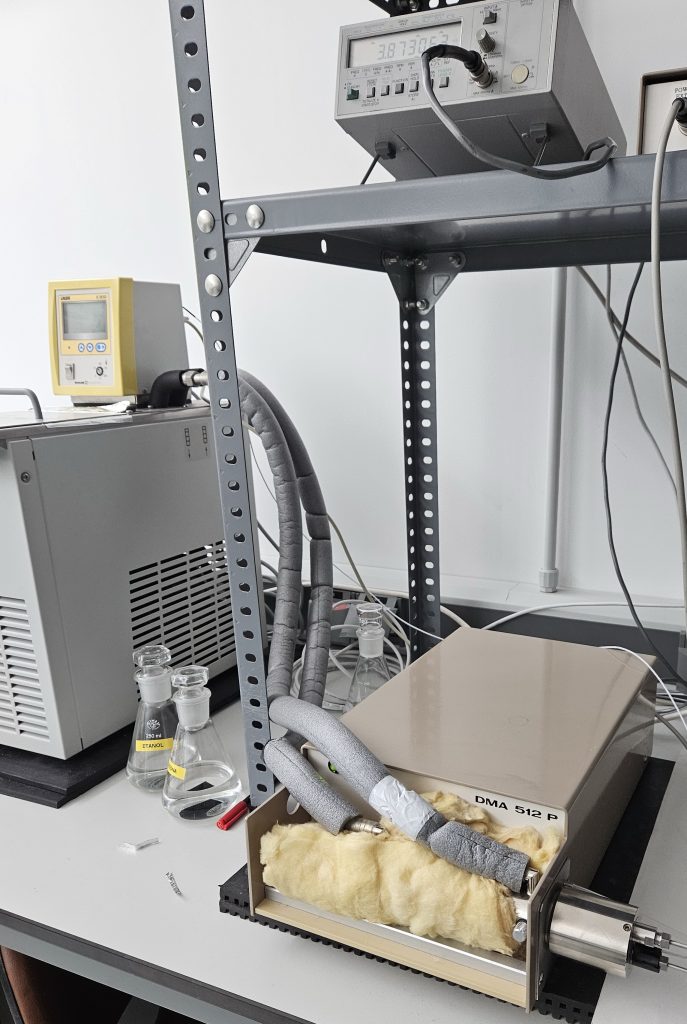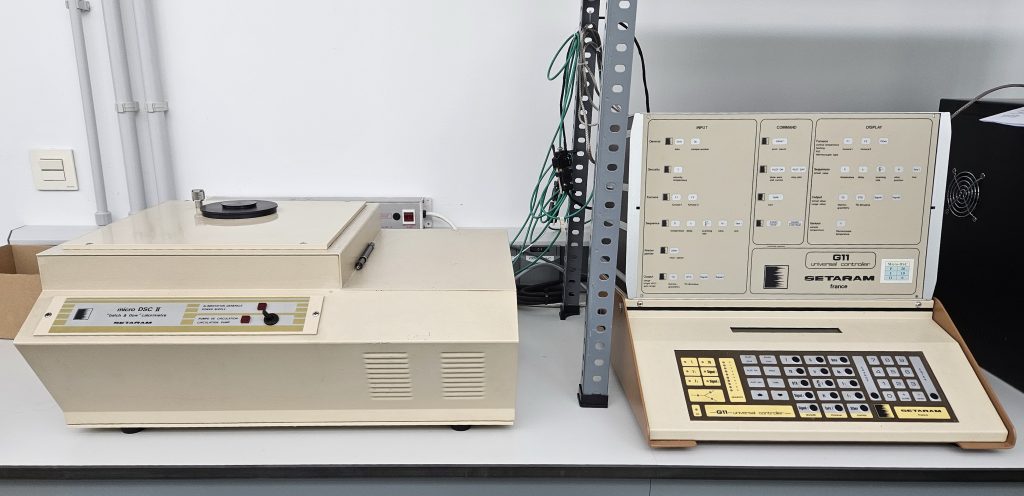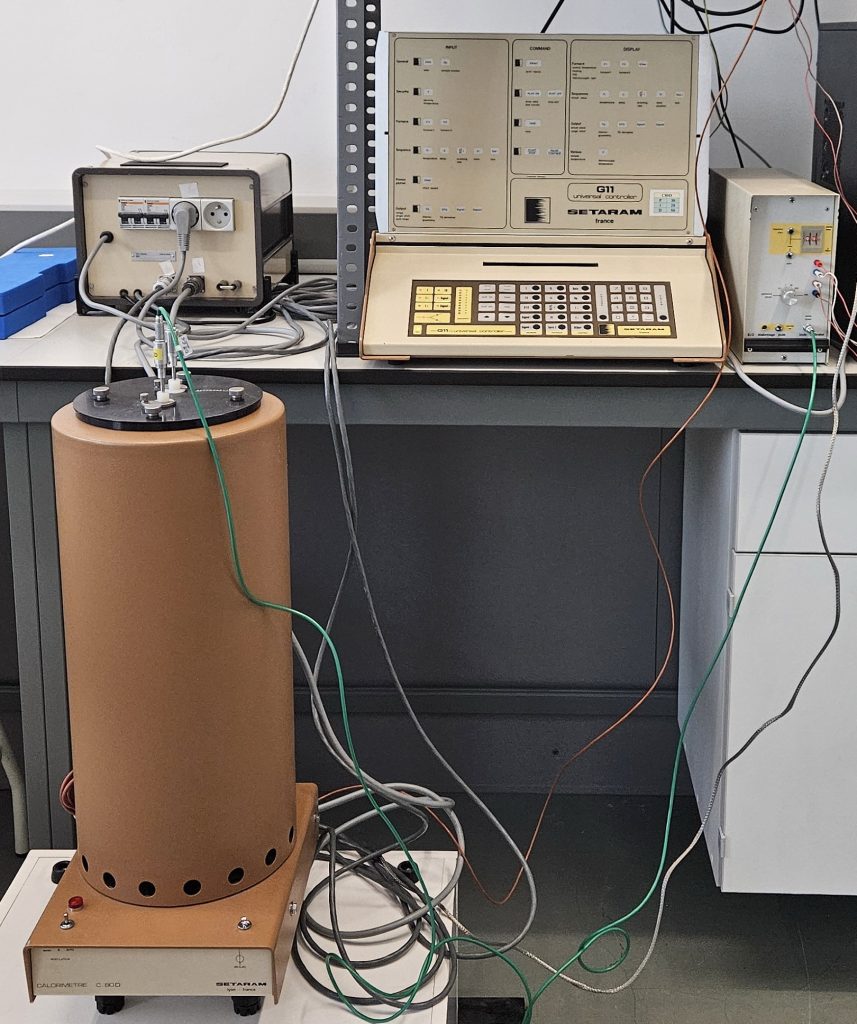Density and thermal coefficients

High pressure densimeter (vibrating tube)
- Model: Anton Paar DMA 512P
Measuring range: temperature = (-20 to 150) °C; pressure = (0 to 700) bar
Low pressure densimeter (vibrating tube)
- Model: Anton Paar DMA 602
Measuring range: temperature = (-20 to 150) °C; pressure = (1 to 3) bar
Automated ambient pressure densimeter (vibrating tube cell)
- Model: Anton Paar DSA 5000
Measuring range: temperature = (0 to 70) °C; pressure = (1 to 3) bar
Description: all vibrating tube density meters are based on a U-tube of borosilicate glass or stainless steel filled with the liquid of interest which is made to vibrate. By measuring the amplitude of the motion at different excitation frequencies, the resonance period of the tube is determined. The square of the resonance period depends linearly on the density of the liquid to be measured.
Note: density measurement as a function of temperature allows the isobaric thermal expansion coefficient to be obtained. If the density is measured as a function of pressure, the isothermal compressibility coefficient can be determined.
Speed of Sound
Automated ambient pressure speed of sound analyzer (ultrasonic cell)
- Model: Anton Par DSA 5000
Measuring range: temperature = (0 to 70) °C; pressure = (1 to 3) bar
Description: the equipment determines the speed of sound by measuring the propagation time of short acoustic pulses at 3 MHz center frequency, which are continuously transmitted along the cell. Standard error of measurement 0.2 m·s-1.
Note: the combined measurement of density and sound velocity allows the isentropic compressibility coefficient to be obtained. And if these measurements are combined with those of the isobaric thermal expansion coefficient and the isobaric heat capacity, the isothermal compressibility coefficient can be determined.
Enthalpy/heat of mixing
Tian-Calvet Calorimeter
- Model of handcrafted construction, of very high sensitivity
Measuring range: temperature = ambient up to 150 °C; pressure = 1 bar (but depending on the cell)
Heat capacity, process enthalpy/heat, thermal conductivity

Differential Scanning Micro Calorimeter (DSC)
- Model: Setaram MicroDSC II
Measuring range: temperature = (-40 to +150) °C; pressure = (1 to 60) bar with liquid isobaric heat capacity cell, but depends on the cell.

Tian-Calvet micro calorimeter
- Model: Setaram C80
Measuring range: temperature = ambient up to 300 °C; pressure = cell dependent
Description: these devices are conduction calorimeters by the isothermal-isobaric method, keeping constant the temperature of the environment of the vessel containing the sample and measuring the energy in the form of heat exchanged between both, i.e. between vessel and environment. The device consists of a casing, different layers of insulation and thermostatization with their respective thermometric resistances, and an external enclosure where a set of high-sensitivity thermocouples are placed regularly distributed and an internal enclosure prepared to contain the cell with the sample of interest. The assembly is differential, since it consists of 2 sets (external enclosure + thermocouples + internal enclosure) called reference and laboratory. They are connected in opposition, that is, the outputs of the thermocouples are connected in such a way that any thermal disturbance detected in the reference assembly is subtracted from the output detected in the laboratory assembly, thus eliminating external thermal disturbances.
Enthalpies and temperatures of solid-liquid phase change and of glass transitions and crystallization
Differential Scanning Calorimeter (DSC and modulated DSC)
- Model: Q2000 Thermal Analysis Instruments
Measuring range: temperature = (-90 to 400) °C; pressure = (1 to 3) bar
Considerations: equipment to work with liquid and solid samples. It can perform modulated differential scanning calorimetric experiments to measure heat capacity.
Dielectric permittivity
Precision Impedance Analyzer + Liquid Cell
- Model: Agilent 4294A Impedance Analyzer + Agilent 16452A Liquid Text Fixture
Measuring range: temperature = (-20 to +125) °C, but depends on the thermostatic bath in which the liquid cell is immersed; pressure = 1 bar
Description: equipment for the measurement of the complex relative dielectric permittivity of fluid samples at frequencies between 40 Hz and 30 MHz. It is based on the measurement of the electrical impedance of a non-ideal plane-parallel capacitor by means of the self-balancing bridge method in 4TP (Four Terminal Pair) configuration.
Refractive index
Automatic refractometer
- Model: Bellingham + Stanley RFM970
Measuring range: temperature = (0 to 80) °C; pressure = 1 bar
Description: equipment for the determination of the refractive index in the visible region, at the sodium doublet wavelength (589.3 nm). It is based on the total reflection of a light beam emitted by an LED diode and the optical detection of the critical angle on a photodiode array. The standard error in the refractive index is 0.00008.
Viscosity
Automated Ubbelohde viscometers (capillary)
- Model: Schott-Gerate AVS-350
Measuring range: temperature = (20 to 40) °C; pressure = 1 bar
Description: viscometers of the suspended level type. The liquid of interest is suspended from the capillary which it fills completely, thus ensuring uniform hydrostatic pressure. This type is used to measure the kinematic viscosity of transparent Newtonian liquids up to 105 mm2·s-1. Its operation is based on the Hagen-Poiseuille equation of fluid dynamics, which relates the viscosity of a liquid flowing through a cylindrical tube (capillary) to the time it takes to pass between two fixed marks.
Liquid-liquid phase equilibrium
Self-built optical cell
- Measuring range: temperature = (5 to 90) °C; pressure = 1 bar
Description: instrument for the determination of the immiscibility of liquid mixtures by determining the opacity of a laser beam as it passes through the cell under controlled conditions of temperature and agitation.
